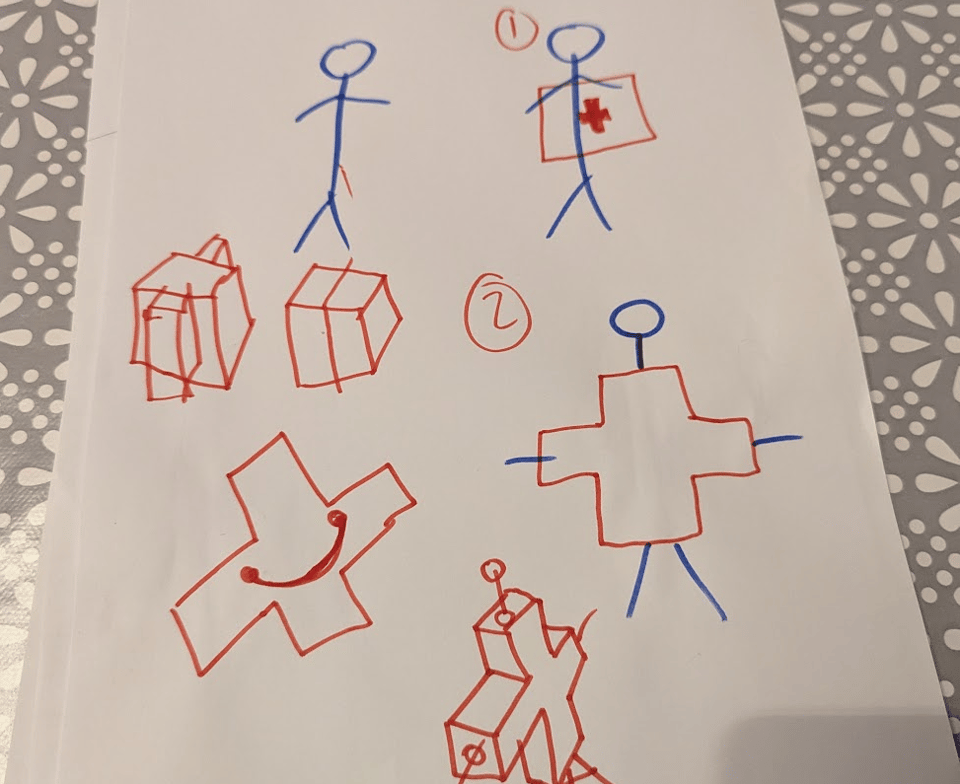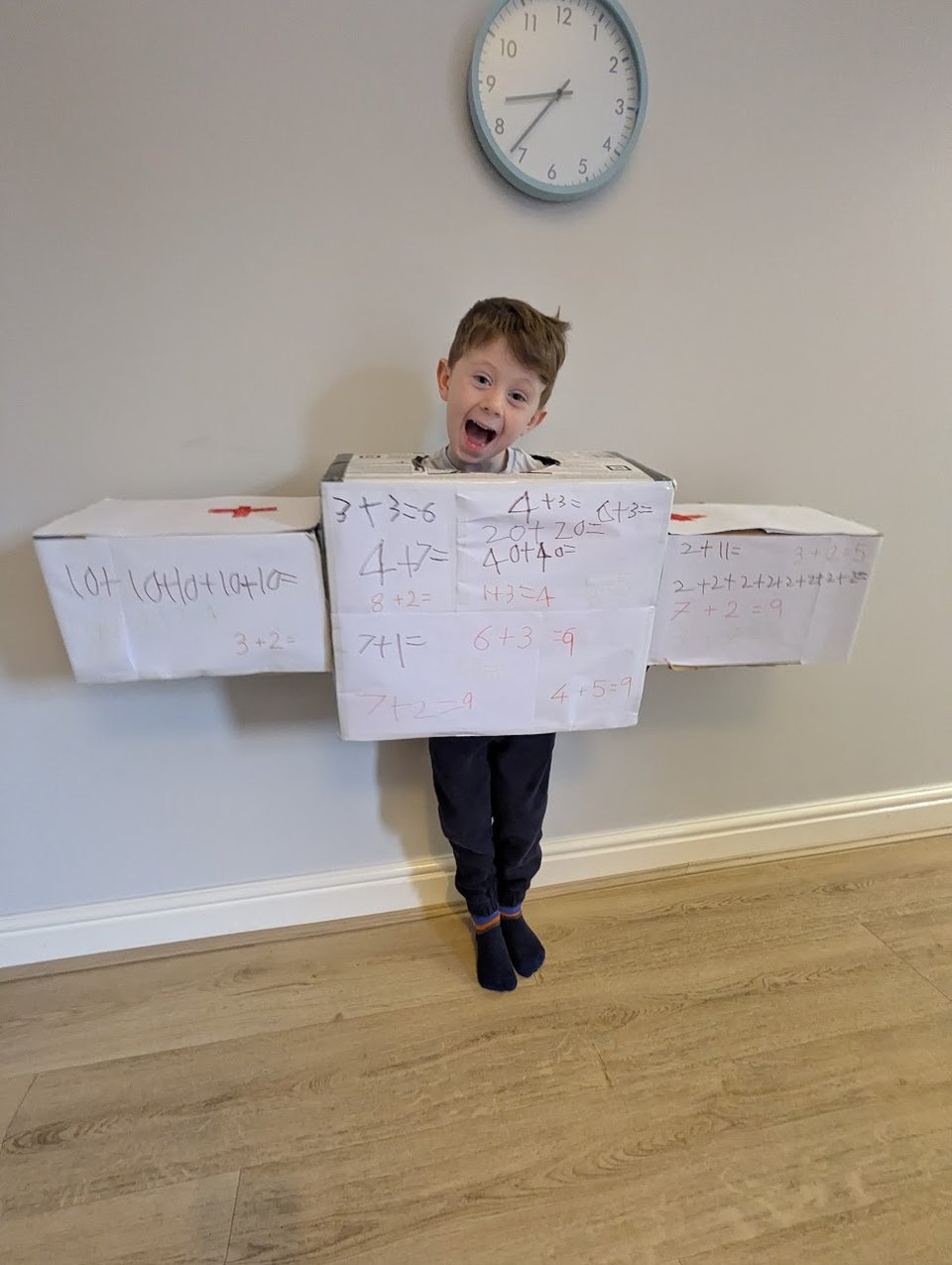Explaining Pi to a child
Celebrating Pi Day with my son brought on a whirlwind of maths, costumes, and chaotic fun
Today is “Pi Day” – 14th March, or 3/14 if you follow the obviously-flawed American standard for expressing dates. As I hinted last week, my son’s school is celebrating today by asking kids to dress up again as “something maths-related”. Thank you, school!
At 6.30am my almost-six-year-old son bounded into my bedroom and woke me from slumber. He’s developed a mildly disconcerting habit of prefacing most of his statements with what I can’t stop myself from thinking of as trailers: eg:
“Dad, can I tell you something?”
“Do you know what I’m about to say?”
“I’ve got something to tell you:”
I groggily rolled over to make space for him in the bed, and he earnestly began telling me about the Wizard of Oz-themed dream he’d just had, complete with songs. As I rubbed my eyes blearily, I remembered it was Pi Day.
Down the rabbit hole
Explaining things to curious kids often becomes akin to a Matryoshka doll, where each new word or concept requires an additional explanation or context to explain the previous point. Pair this with a kid whose favourite questions all begin with “why”—or perhaps with “Can I ask you something? Why…”—and you have a recipe for an infinitely recursive conversation.
Forgetting this, though, I asked him if he remembered that today was Pi Day. He did, and like a fool, I blurted out “do you know why they call it Pi Day?”. I’d just opened up the first doll.
Table stakes first: make the obvious joke about Pi/pie. It didn’t land, though, because first I needed to explain about the Greek alphabet and ancient mathematicians. No matter; I can roll this one out again next year. I give a broad-strokes outline of π, its approximate value, and global significance.
“Why is it today, though?”, he innocently asks. I find myself first explaining that today is the 14th of March, and therefore… 3.14. “What’s a decimal point?”, he immediately follows up. As I scratch my head and roll over in the bed, I begin fumbling a summary of what fractions are, settling on “it basically means three-and-a-bit”.
But I realise I still haven’t answered the date question. I’m slightly unwilling to draw him into the complex world of ISO standards and their international variants, so I pretend that I’m okay with dates being expressed as MM/DD in order to make tenuous “jokes” about their similarities with mathematical constants. I feel a little part of me die because, of course, like any right-minded individual I prefer DD/MM (or YYYY-MM-DD, for the truest beauty) but he’s not ready for this degree of conflict yet.
So far it’s 6:40am and I’ve been forced to explain the Greek alphabet, the concept of decimals, date notation systems and a weak joke about pies, and I haven’t even got to the usages of Pi yet. I take a breath.
A no-go area
“Okay, imagine a circle”, I begin, and he sketches one in the air with his hands. “No, actually, a square”, I correct myself, deciding to work my way up to wowing him with the sheer utility of Archimedean geometry. “Look at that wall”, I say, sitting up to point at one of my bedroom surfaces as I ponder whether it actually is a square (of course it isn’t). “Now, er, imagine you wanted to, er… paint it”.
When would a nearly-six-year-old need to know the area of a square? My mind races like a slug through molasses as I try to think of a scenario where this knowledge may excite and inspire him. I give up.
Instead I explain how we can easily measure the area of a square by multiplying its sides, but then drop the bombshell: it’s quite hard to do this with a circle. I think the gravity of this moment is lost on him as he scans the room with interest, perhaps still thinking about what colour paint he’d like to daub my bedroom with.
“So, ancient mathematicians discovered this magic number they could use to work out the area of a circle”, I confide in him, dropping my voice to a hushed tone to ensure he understands that I’m conferring the wisdom of the ancients upon him. He’s clever enough now to know that when grown-ups use the word “magic”, that he’s being patronised. I struggle once more to think of a scenario where a child would benefit from knowing the area of a circle.
But incredibly, he’s found one for me. “Like… a camping circle!” he says, with verve. I bite back my confusion (what is he talking about?) as he adds “so you can see how many tents you can fit inside the circle”.
“Exactly!” I beam, as I smell the first notes of the coffee Maddy is brewing downstairs. “That’s what Pi helps you calculate. And that’s why we’re celebrating Pi Day today, because it’s the 14th of March, and Pi is equal to 3.14, and March is the third month, and if you write today’s date in an obviously-backwards way, ignoring all logic and standardisation, and pretend that it’s acceptable, then you get 3-1-4, which is…”
He’s out of the bed now and running downstairs, shouting something about Rice Krispies. I wearily put on my slippers and follow the scent of caffeine, wondering how I got fooled into opening the first doll again so easily.
Mini-feels this week
On the plus side
It’s a Pi Day special today: for the third week running, I had to dress my son in a costume for school. Two weeks ago it was the Portuguese flag, last week it was as a rock star, and today it’s… the “+” symbol.
This was his suggestion, and because I didn’t want to be one of those parents who sends their kid to school wearing something so meticulously designed that it’s clear the child had nothing to do with it, I decide to follow his lead. We sketch out on paper what he wants it to look like, and it becomes clear that he wants a full-3D costume, made of cardboard boxes. Thankfully, Birmingham’s bin collection service has been on strike for months so we have tons of leftover recycling. I head to the shed to grab some boxes.

I was up all evening the night before, sellotaping cardboard boxes together and covering them with printer paper so he can decorate them with “number sentences”, whatever they are. When I emerge downstairs after dressing and showering, I find Ted posed in his costume:

I briefly feel guilty about sending him to school in something so obviously disruptive, and worry that he’ll trail a path of destruction through every room he enters, sweeping things to the floor with his albatross-like wingspan of cardboard. Then I remember how much inconvenience and disruption the school has caused me, by introducing these multiple dress-up days, and suddenly I’m wondering if the costume isn’t chaotic enough.
I send him off to school with a smile on my face and a song in my heart – and that’s definitely been a plus.